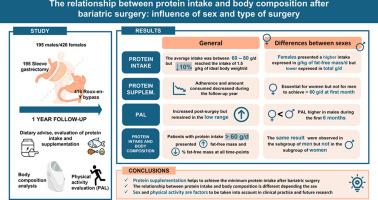The relationship between protein intake and body composition after bariatric surgery: Influence of sex and type of surgery
IF 7.4
2区 医学
Q1 NUTRITION & DIETETICS
引用次数: 0
Abstract
Background & aims
Achieving the recommended protein intake (PI) is one of the main challenges of dietary monitoring in order to minimize fat-free mass (FFM) loss after bariatric surgery (BS). Protein supplementation is recommended to achieve this goal. However, the most appropriate PI recommendation scheme as regards amount and timing, as well as the relationship between PI and body composition after surgery, still needs to be studied. The aim of this study was to analyze PI and protein supplementation as well as their relationship with body composition during the first year after BS.
Methods
We studied a sample of 621 patients (195 males/426 females) who underwent BS (205 sleeve gastrectomy/416 Roux-en-Y gastric bypass). Preoperative and first-year follow-up data of body composition, dietary intake and physical activity level were analyzed.
Results
Average PI was higher than 60 g/d but lower than 80 g/d at all time-points. Less than 10 % of patients achieved the target of 1.5 g/kg of ideal body weight (IBW)/d. Women presented a higher PI expressed in g/kg of IBW/d in the first and three months after BS (P < 0.05) and in g/kg of FFM/d at all follow-up times (P < 0.001). Adherence to protein supplementation decreased over the first post-operative year. Supplementation was essential for women to achieve the minimum PI of 60 g/d 1 month after surgery. Men with a higher PI than 60 g/d during the first year exhibited a lower fat mass (FM)% and higher FFM% than those who did not achieve this target during all the follow-up points. This effect was not observed in women. The average physical activity increased significantly after BS (P = 0.01), observing a positive correlation between FFM% and PAL at months 1, 6 and 12 of the follow-up (P = 0.05).
Conclusions
Protein supplementation helps to achieve the minimum PI threshold indication of 60 g/d, but patients did not achieve the recommended intake of 1.5 g/kg of IBW/d. PI and its relationship with the evolution of body composition after BS is different depending on sex. More research is needed to increase knowledge about the most appropriate PI, supplementation scheme and its impact on body composition, taking into account factors such as sex and physical activity to personalize protein recommendations.

减肥手术后蛋白质摄入量与体成分的关系:性别和手术类型的影响
背景和目的达到推荐蛋白质摄入量(PI)是饮食监测的主要挑战之一,以最大限度地减少减肥手术(BS)后的无脂质量(FFM)损失。建议补充蛋白质来达到这个目标。然而,最合适的PI推荐方案在量和时间上,以及PI与术后体成分的关系,仍需进一步研究。本研究的目的是分析在BS后第一年PI和蛋白质补充及其与体成分的关系。方法我们研究了621例接受BS(205例套管胃切除术/416例Roux-en-Y胃旁路术)的患者(195例男性/426例女性)。分析术前及随访1年的身体成分、饮食摄入及体力活动水平。结果各时间点平均PI均大于60 g/d,小于80 g/d。不到10%的患者达到了1.5 g/kg理想体重(IBW)/d的目标。女性在BS后的第一个月和三个月以g/kg IBW/d表示的PI较高(P < 0.05),在所有随访时间以g/kg FFM/d表示的PI较高(P < 0.001)。术后第一年内,蛋白质补充的依从性下降。术后1个月,女性要达到60 g/d的最低PI,补充叶酸是必不可少的。在第一年PI高于60 g/d的男性表现出较低的脂肪质量(FM)%和较高的FFM%,而在所有随访点都没有达到这一目标。在女性中没有观察到这种效应。BS后平均体力活动显著增加(P = 0.01),随访第1、6、12个月时FFM%与PAL呈正相关(P = 0.05)。结论补充蛋白质有助于达到60 g/d的最低PI阈值指征,但患者未达到1.5 g/kg IBW/d的推荐摄入量。在BS后,PI及其与身体成分进化的关系因性别而异。需要更多的研究来增加对最合适的PI,补充方案及其对身体成分的影响的了解,考虑到性别和体育活动等因素来个性化蛋白质建议。
本文章由计算机程序翻译,如有差异,请以英文原文为准。
求助全文
约1分钟内获得全文
求助全文
来源期刊

Clinical nutrition
医学-营养学
CiteScore
14.10
自引率
6.30%
发文量
356
审稿时长
28 days
期刊介绍:
Clinical Nutrition, the official journal of ESPEN, The European Society for Clinical Nutrition and Metabolism, is an international journal providing essential scientific information on nutritional and metabolic care and the relationship between nutrition and disease both in the setting of basic science and clinical practice. Published bi-monthly, each issue combines original articles and reviews providing an invaluable reference for any specialist concerned with these fields.
 求助内容:
求助内容: 应助结果提醒方式:
应助结果提醒方式:


